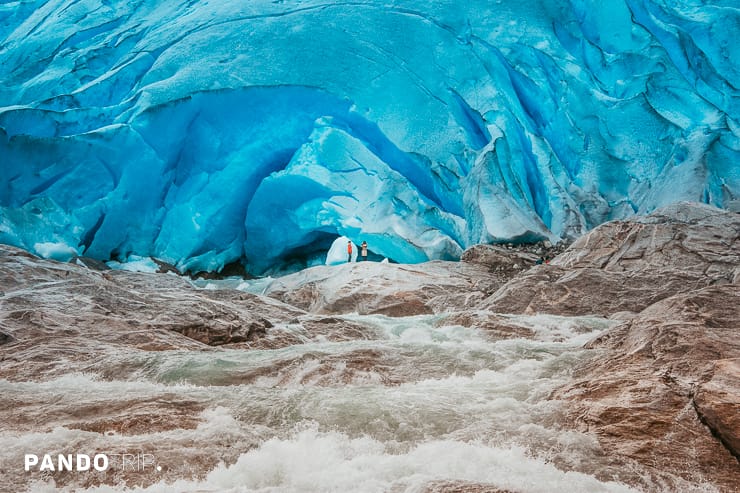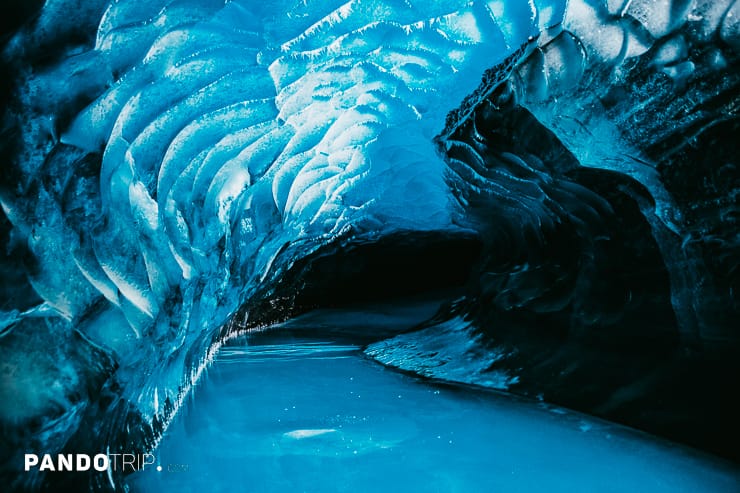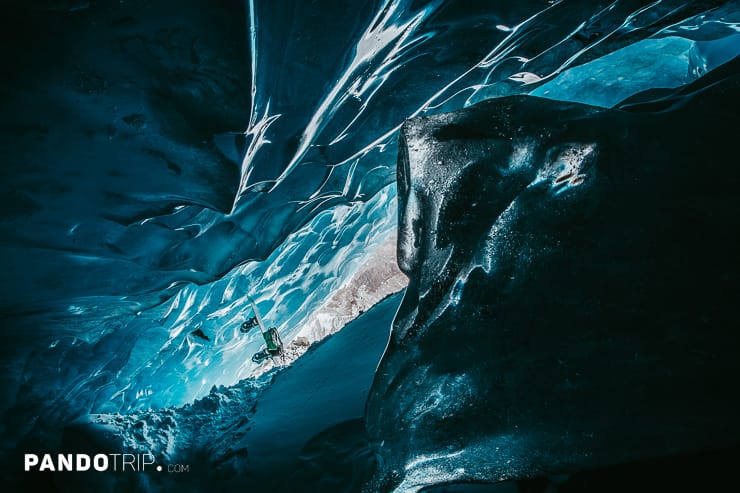Ice caves are amazing wonders of nature, and any winter lover is sure to enjoy visiting them. However, it’s not so easy, so to help you out, we’ve done tons of research and come up with a list of the world’s best ice caves to visit. They are incredible to look at, but even better to explore.
How we made this list
First of all, we use the term “ice cave” very broadly and loosely in this article. We don’t focus on the difference between ice caves and glacier caves. To keep things simple, any cave that has ice inside is considered an “ice cave.”
Secondly, we have only listed caves easily accessible to the average tourist, either with a guided tour or independently. Therefore, caves that require special equipment or training have been excluded from this list.
And, lastly, we’ve focused on the countries that are home to the best ice caves in the world and provide a list of specific caves you can visit there.
# Ice Caves in Iceland
Iceland is the best country for ice caving. There are many amazing things to do in Iceland, but ice caves are often the primary reason tourists visit.
Ice Caves in the Vatnajökull Glacier
The most popular ice caves in Iceland are found inside the Vatnajökull glacier. At 8,100 km2, it’s Europe’s largest glacier and covers about 8% of the country.
The Vatnajökull glacier ice caves, also known as the Blue Ice Caves, are undoubtedly the most beautiful in Iceland. It’s impossible not to be fascinated by the bright crystal blue color of the caves. Unfortunately, for safety reasons, the ice caves are only accessible from November to March and a guided tour is recommended.

Katla Ice Caves in the Mýrdalsjökull Glacier
If you’re visiting Iceland in summer, you can enjoy the natural Katla Ice Caves, which are open all year round. Located in the Mýrdalsjökull Glacier, it’s the closest authentic ice cave to Reykjavík.
The main difference between the Katla Ice Caves and the Vatnajökul Blue Ice Caves is the color of the ice. Katla Ice Caves are much darker and don’t contain as much blue ice.

Langjökull Ice Cave – the world’s largest man-made ice cave
Langjökull Ice Cave is the closest ice cave to Reykjavík. It’s a man-made tunnel located inside Europe’s second-largest glacier – Langjökull.
The winding tunnel is 550 meters (1,640 feet) long and goes 30 meters (98 feet) down into the glacier. There are five man-made chambers inside, and one of them is even designed to be a wedding venue. The tunnel is accessible all year round.

The Glaciers and Ice Cave Exhibition inside Perlan, Reykjavik
If you have just a couple of days in Reykjavik, you can still experience ice caving. In the Perlan Museum, you can find the first indoor ice cave in the world. The Glacier and Ice Cave Exhibition, which is part of the larger Wonders of Iceland exhibition, gives you the ability to enter a 100-meter long ice cave and learn more about Icelandic glaciers.

# Ice Caves in the USA
The USA has a relatively small number of ice caves, or at least the number is not as high as you could expect for a country with so many mountains. However, the number is high enough to visit some caves there. The best-known American ice caves are located in Washington, Alaska and Wisconsin.
Mendenhall Glacier Ice Caves, Juneau, Alaska
A 12-mile-long Mendenhall Glacier is a popular tourist destination located 12 miles from downtown Juneau in southeast Alaska. The glacier itself is a must-visit destination in Juneau, but the ice caves are the jewel in the crown.
You can get to the ice caves either by hiking or via kayak or canoe. Mind you, all of the options are challenging. The hike takes about 8 hours, and it’s quite a strenuous and demanding activity. Kayaking is probably easier, but still, you should have some experience. If you have never kayaked before, it’s not the right place to start. However, some tour operators offer large canoe tours, which are much more suitable for beginners. It’s recommended that you only visit Mendenhall Ice Caves with an experienced guide. You can find some of them online.
Also, keep in mind that none of the tours will guarantee you an ice cave visit. This is because glaciers, and especially ice caves, are constantly changing, melting and collapsing. Some caves can last for months or weeks, others only exist for a few days before collapsing.

Apostle Island Ice Caves on the shores of Lake Superior, Wisconsin
Visiting Apostle Islands Ice Caves is a “bucket list” winter activity. The caves themselves are spectacular, but the way you get there is a remarkable experience too, as you need to cross one of the frozen Great Lakes to get to them.
Usually, the lake becomes sufficiently frozen between late January to mid-March. But it depends on the year. For example, in 2021, it was impossible to visit Apostle Islands Ice Caves, as the ice on the lake wasn’t solid enough. So before you go, check the Apostle Islands National Lakeshore website.

Big Four Ice Caves, Washington
The Big Four Ice Caves are a series of ice caves at the bottom of the Big Four Mountain. They are reachable by a popular trail 90 minutes northeast of Seattle in the North Cascades. The hike is perfect for hikers of all levels and you can usually view the caves from August through early October.

# Ice Caves in Switzerland
Switzerland’s most popular and easily accessible ice caves are not natural, but dug out of ice glaciers. Mind you, artificial doesn’t mean worse – they still are very beautiful and totally worth a visit.
Jungfraujoch Ice Palace, Fieschertal
Located about 20 meters under the Aletsch Glacier, the Ice Palace is one of the top attractions of Jungfraujoch. In the 1930s, mountain guides built paths and halls inside the glacier using only picks and saws. Today, about two million people a year stroll through that icy area that covers 1,000 square meters.
Visitors can walk inside a glacier and enjoy various sculptures and artwork made of ice that decorate the palace rooms. What’s more, you can even enjoy a drink in the ice bar, where even the counter is made of ice.
Jungfraujoch, also referred to as the Top of Europe, it’s not only home to the Ice Palace. You can also find the highest train station in Europe at an elevation of 3,454 meters (11,332 feet). Secondly, you can visit the second-highest observation deck in Switzerland, called the Sphinx observation deck, which offers sensational views of the Aletsch glacier.

Ice caves at the Aletsch Glacier
The Aletsch Glacier is the largest in the Alps. It is 23km (14 miles) long and covers about 86 square kilometers. The glacier is one of the most popular attractions in the Alps and has many glacier tours. Some of them offer ice caving as well.

Mittelallalin Ice Pavilion, Saas-Fee
The 5,500 cubic meter large Ice Pavilion rivals the size of the Eisriesenwelt in Austria. The ice cave was dug inside the ancient Fee Glacier. The place is similar to Jungfraujoch Ice Palace and also offers various ice sculptures, exhibitions and events.
Mittelallalin is accessible by the Metro Alpin, the highest underground train in the world. The highest revolving restaurant in the world, “threes!xty” is also located there.
Rhone Glacier Ice Grotto
The Rhone Glacier Ice Grotto is a must-see site when driving on the famous Furka Pass road. This is the most easily accessible ice cave on our list. The entrance of the Rhone Glacier Ice Grotto is just 200 meters away from Hotel Belvédère.
It’s a man-made cave (or, better said, tunnel ) carved inside the Rhone Glacier in 1870. The path inside is about 100 meter long (328 feet), and visitors can enter it independently without a guide.
You might be interested: Best Places to Visit in Switzerland

# Ice Caves in Austria
About 16,300 caves are known about and registered in Austria, and 1,200 among them are considered ice caves. The number of ice caves compared to the size of the country is one of the highest in the world.
The two most beautiful ice caves you can visit in Austria are Eisriesenwelt and Dachstein. Located close to the German border and only 75 km from each other, both are popular tourist spots in Austria.
Eisriesenwelt Ice Cave – The Largest Ice Cave in the world
The Eisriesenwelt (German: “World of the Ice Giants”) is an hour’s drive from Salzburg in Werfen. Covering 42 km inside the Hochkogel Mountain, it’s the largest ice cave in the world.
Visited by about 200,000 tourists every year, it’s an easily accessible cave. Visitors can buy tickets online and the tour takes about one hour. However, the cave is closed to the public during winter and you can only visit it between May and October.

Dachstein Giant Ice Cave
The Dachstein Giant Ice Cave gives you a different experience compared to Eisriesenwelt. Because of its proximity to one of the most touristy spots in Austria, Hallstatt village, the cave offers more tourist attractions. For instance, cave bears, a rope bridge and a light & sound show. It might not be interesting for adventure seekers, but it’s a perfect place for families with kids.

# Ice Caves in France
France is not known for its ice caves, though the Mer de Glace Ice Cave in Chamonix is worth visiting.
Mer de Glace Ice Cave
It’s quite symbolic that the most popular French ice cave is located near Chamonix, where the world’s first Winter Olympics was held in 1924.
Chamonix is a mecca for those looking for some proper winter fun and offers some of the best skiing in Europe. It’s also home to Mont Blanc (one of the highest mountains in Europe) and the Mer de Glace (French: “Sea of Ice”) glacier. 7km long and 200 meters deep, the Mer de Glace is the largest glacier in France and one of the longest in the Alps. The most impressive site there is Grotte de Glace, a 100 meter long ice cave.
This ice cave was carved out in 1946 and recreated every year, since the glacier is moving about 70 meters a year.
To access the Grotte de Glace visitors need to take a 20-minute Montenvers Train ride from Chamonix town center. Then descend via a small cable car and walk down about 400 steps.

# Ice Caves in Slovakia
Few countries in the world have so many caves as Slovakia. There are more than 7,000 caves in Slovakia, and about 60 of them are filled with ice. The two most popular and best-known ice caves are Dobšinská Ice Cave and Demänovská Ice Cave.
Dobšinská Ice Cave
Located in the eastern part of Slovakia in the Slovak Paradise mountains, Dobšinská ice cave is one of the most famous ice caves in the world. It’s the biggest ice cave in Slovakia and one of the largest in Europe too. The 1,232 meter long Dobšinská ice cave has ice all year round, as the temperature inside varies between 0 to -4 Celsius.
Until 1946, it was possible to visit the cave on your own and even public ice skating was allowed there. However, today it’s only accessible via a guided tour. The cave tour takes around half an hour.

Demänovská Ice Cave
In the northern part of the Low Tatras in Demenovska valley, there’s another ice cave open to the public – Demänovská Ice Cave. It’s the second-largest cave of its kind in Slovakia. Being 2,445 meters in length, it’s the longest cave in Slovakia.
Visitors can take a guided tour to the cave, which takes about 45 minutes.

# Ice Caves in Norway
Norway is best known for its fjords and Northern lights, but it can also be proud of its glaciers. The Norwegian mainland is home to more than 2,500 glaciers, plus about 2,100 glaciers on Svalbard. Some of those glaciers offer an amazing ice cave experience.
Nigardsbreen Ice Cave, Luster, Norway
Located in the Nigardsbreen glacier, the Nigardsbreen Ice Cave is one of the most beautiful sights in Norway. Its beauty has been enhanced by global warming – external melting and internal freezing have created many spectacular icicles in the cave.
The Nigardsbreen glacier is the most accessible branch of the Jostedalsbreen, the largest glacier in continental Europe. But even though the Nigardsbreen Ice Cave is located on one of the most easily accessible glaciers in the world, it can’t be entered without a guide. The guided tours can be booked online, but keep in mind that the group hike to the cave takes about 5-6 hours.

Svalbard Ice Caves near Longyearbyen
The Svalbard Islands are a unique place you can visit on Earth. Located in the Arctic Ocean, in the middle between the North Pole and Norway, the islands are home to a few thousand polar bears and about 3,000 humans. Most of the inhabitants (about 2,400) live in Svalbard’s capital Longyearbyen.
Svalbard’s cold climate means that glaciers there are solid and you can safely visit the ice caves. However, because of the presence of polar bears, it’s not advisable to explore Svalbard outside Longyearbyen without carrying a gun. So the best way to explore the ice caves there is by joining a tour with a local guide, who will probably carry to protect you.
There are several ice caves in Svalbard that you can visit. Some of them are quite far away from the main town Longyearbyen, but a few that are closer can be visited on a day tour.
There are many ice caves tours available online. You can choose how to visit them, either on foot, on skis, by snowmobile or even dog sled.

# Ice Caves in Canada
Ice caves in Canada are more of a local thing rather than touristy attractions. However, some caves are popular among travelers too.
Athabasca Glacier Ice Caves, Jasper National Park, Canadian Rockies
One place where it’s possible to visit ice caves in Canada is at the Athabasca Glacier. Located in Jasper National Park in the Canadian Rockies, it’s one of the most accessible glaciers in Canada and the most-visited glacier in North America. What’s more, the glacier is very close to the Icefields Parkway, one of the most beautiful roads in the world.
It’s advisable to visit Athabasca Glacier Ice Caves via a guided tour. Most tours are seasonal, are available from May to October and can be booked online.
Just keep in mind that the chances of visiting ice caves are not 100 percent. Because of climate change, the glacier is shrinking, and caves available a few years ago have now collapsed. Mind you, even without ice caves, the experience of walking through the snow and ice is worth your time.

Blackcomb Glacier Ice Caves, Whistler, British Columbia
The Blackcomb Glacier Ice Cave is a popular tourist attraction known as one of Whistler’s 7 Wonders of Winter. The cave is accessible on skis and you need to be a fairly good skier to get there. If you’re not, you can take a helicopter tour, though.
The cave’s opening times differ from year to year, but if you want to visit it, go at the beginning of the ski season, since Ski Patrol usually rope them off as it gets further into the season.

The Kluane Ice Cave, Haines Junction, Yukon
The Kluane Ice Cave located near Haines Junction, Yukon was a popular destination between tourists and locals. Unfortunately, in May of 2019, the cave collapsed.
You might be interested in: The surreal ice bubbles of Abraham Lake, Canada
# Ice caves in Germany
Germany is best known for its medieval towns, castles and beer, not because of ice caves. Though the country has some caves, most of them are located near the Austrian border in the Berchtesgaden Alps. The problem is that you can’t visit most of them. There’s only one ice cave in Germany open to tourists – Schellenberg Ice Cave.
Schellenberg Ice Cave
The Schellenberg Ice Cave is Germany’s largest ice cave. It has an estimated ice volume of about 60,000 cubic meters, and the explored length is 3,621 meters.
Schellenberg Ice Cave is open between June and October and can only be reached after a couple of hours’ hike from the Untersbergbahn cable car station. At the entrance, you must join the guided tour, which takes about 45 minutes. Unfortunately, you are not allowed to enter the cave on your own.
